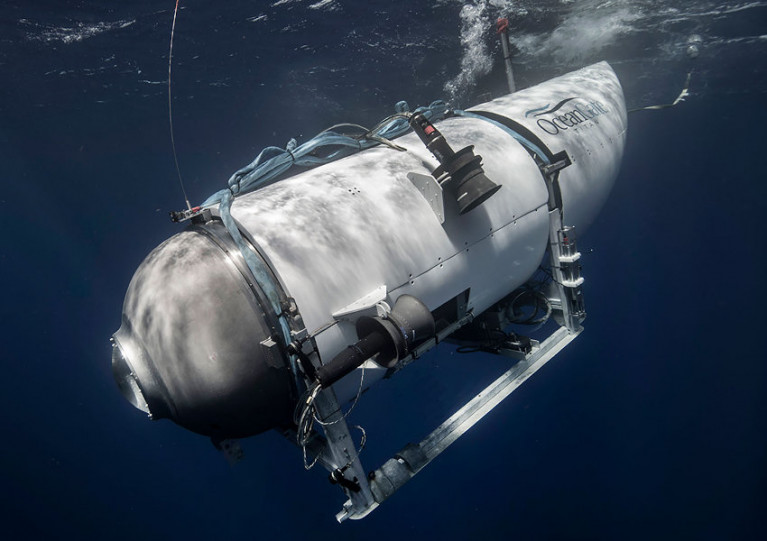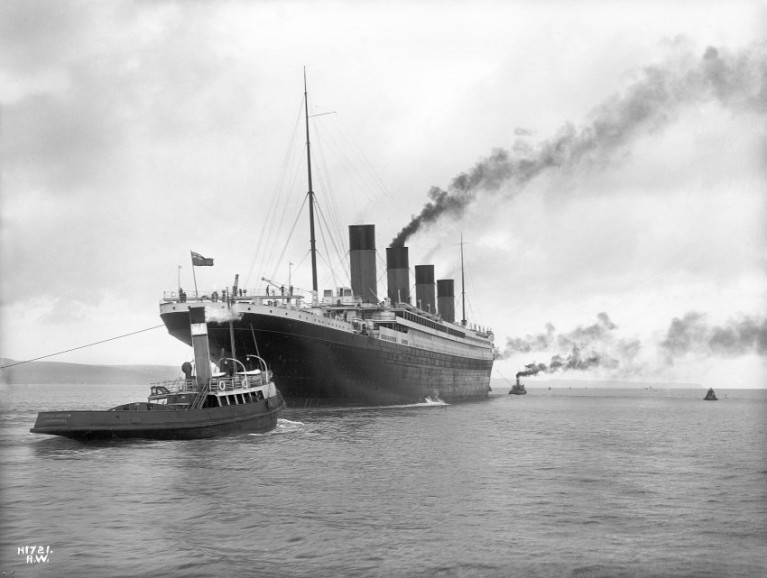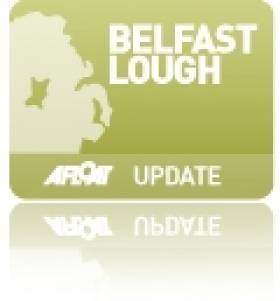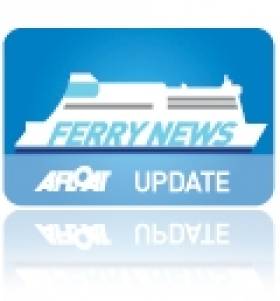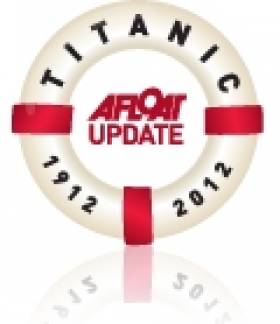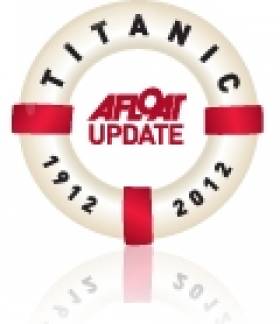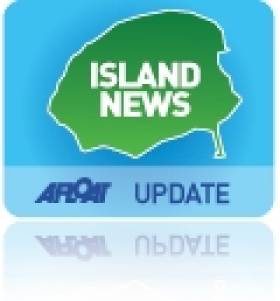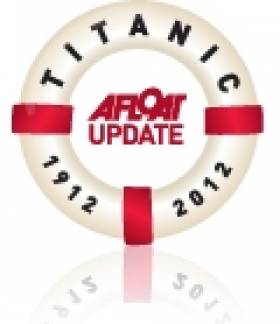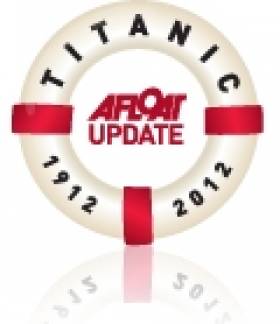Displaying items by tag: RMS Titanic
Rescuers are racing against the clock to locate and retrieve a tourist submarine that’s gone missing while on a dive to view the Titanic wreck site.
According to The Irish Times, prominent maritime experts and explorers are among the five people on board the mini submarine which lost contact with the surface less than two hours after going below on Sunday afternoon (18 June).
The missing vessel is OceanGate’s Titan, which since 2021 has been running expeditions for paying guests to the wreck of the ill-fated, Belfast-built ocean liner some 4km below the North Atlantic, as previously reported on Afloat.ie.
Search teams from the US and Canada are combing the area some 600km off Newfoundland in a “complex” operation as it is unknown whether the mini sub has surfaced or remains on the ocean floor.
And time is of the essence as officials believe the sub’s crew may run out of air between Wednesday (21) and Thursday (22 June).
The Irish Times has more on the story HERE.
Mini Submarine Will Take Paying Guests to Titanic’s Resting Place for First Time in 15 Years
For the first time in 15 years, paying guests will soon be taken nearly four kilometres beneath the ocean’s surface to visit the wreck of the RMS Titanic.
According to Bloomberg, a company called OceanGate Expeditions will launch its dive expeditions and research missions next May using a privately owned five-person mini-submarine.
And already more than 30 eager explorers have signed up at $125,000 (€105,260) apiece for the privilege of getting close to the remains of the ill-fated, Belfast-built ocean liner, which struck and iceberg in the North Atlantic in 1912 just days after her last port of call in Cobh.
While the planned deepwater voyages are for profit, the company insists that research is at their heart, and paying guests will take on the role of citizen scientists as they assist in a technical survey of the wreck site.
Bloomberg has much more on the story HERE.
US Covered Up Submarine Strike On Titanic Wreck, Court Told
A US government agency kept secret an incident at the Titanic wreck site in which it was struck by a submarine, a court has been told.
As the Belfast Telegraph reports, legal papers files in the US allege that officials at the National Oceanic and Atmospheric Administration (NOAA) withheld knowledge about the incident in mid 2019 in which a two-man Triton submarine came into contact with the hull of the ill-fated ocean liner.
The leader of the scientific expedition, by Isle of Man-based EYOS, says any damage caused — as a result of “unpredictable currents” — would have been minor.
The revelation comes amid a dispute over plans by RMS Titanic Inc, the wreck’s legal salvager, to remove its Marconi wireless system from the bottom of the Atlantic for potential exhibition.
The Belfast Telegraph has more on the story HERE.
#TitanicPumpHouse – The Belfast Telegraph writes that the historic pump-house that was used for the dock in which the RMS Titanic was built, is to be transformed into a visitor centre for HMS Caroline.
The listed building is the subject of a new planning application by the National Museum of the Royal Navy, which is working towards reopening HMS Caroline to public view in 1916.
HMS Caroline is one of the most historic fighting ships in the world and is the last remaining survivor of the Battle of Jutland, the largest ever maritime battle during the First World War.
She is to be restored to her former glory and it is hoped she will reopen in time for the centenary of the battle at the end of May 1916. To read more details of the plan, click HERE.
As previously reported on Afloat.ie, repairs were carried out late last year on HMS Caroline that involved vital weatherproofing as part of the major restoration programme.
Calling Cherbourg: All Things Nauting
#FERRY SAILS – Ferry passengers perhaps on a mini-wine break cruise between Rosslare-Cherbourg may be taking a detour to the Cherbourg Nauting Boat Show which is been held this weekend, writes Jehan Ashmore.
Both Celtic Link Ferries and Irish Ferries operate on the continental route to the man-made Norman port originally constructed by Napoleon. The present day bustling town-centre of Cherbourg-Octeville to give its full name is close to the large 1500-plus berth marina at the Port Chantereyne which is hosting the show.
Those attending can buy and sell new and second-hand boats and where there will be exhibitors attending the three-day show which started yesterday. Activities include scuba-diving, dry surf, stand-up-paddle and model-boats on a dedicated pool.
In addition there is a guided-tour on a racing-boat commented by its skipper Eric D'Hooghe from the Figaro Race. Also making an appearance is the French rower Rémy Alnet who will be there to talk about his trans-Atlantic races.
Also on a related note is the La Cité de la Mer which is a museum situated in the former trans-Atlantic liner passenger terminal used during the so called golden era. The history of these liners is recalled in the museum and of course includes the RMS Titanic and the French Line's famous France which as the Norway made a once off anchorage call outside Dun Laoghaire Harbour.
In addition there are displays of submarines including the decomissioned French Navy nuclear-powered submarine Le Redoutable which is located in an adjoining dry-dock.
- Ferry news
- Cherbourg Nauting
- Napoleon Port of Cherbourg
- Port de Cherbourg
- Cite de la Mer
- CherbourgOcteville
- RosslareCherbourg
- Port Chantereyne marina
- Celtic Liink Ferries
- Irish Ferries
- WineBreak Mini Cruises
- Scubadiving
- DrySurfing
- standup paddle
- SUP
- ModelBoats
- New Boats
- SecondHand Boats
- TransAtlantic Liners
- Le Redoutable submarine
- French Navy
- RMS Titanic
- French Line's France
- Cruiseship Norway
- Dun Laoghaire Harbour
- Dun Laoghaire Harbour cruise liner calls
- Dun Laoghaire Harbour Norway anchorage call
- Cruiseships
- Cruiseliners
- Figaro Race
- Eric D'Hooghe
- French rower Remy Alnet
- Remy Alnet
- La Cité de la Mer
Maritime Institute to Host Tributes to Titanic
#TITANIC 100 – In this centenary week of the sinking of RMS Titanic a talk and musical tribute will be held in memory of the disaster this evening (8 pm) in the newly opened maritime museum in Dun Laoghaire as previously reported on Afloat.ie.
Deep-sea diver Rory Golden became the first Irishman to see the wreck of the Titanic and he will present an illustrated lecture. The musical tribute will be led by uillinn piper Eamon Galdubh – where similar music will be aired to that played in the 2nd and 3rd class compartments on the Titanic.
In addition the Maritime Institute of Ireland (M.I.I.) which runs the museum will run its final lecture for the season next week. The lecture 'Titanic -Locked in History' which will be held next Thursday (19th April) at 8pm in the Stella Maris Seafarers Club in Dublin city-centre and is to be presented by Michael O'Flaherty.
For information on both the Titanic Tribute evening (tickets cost €10) call 087 900 7466 and by also viewing the website which includes details about next week's admission free lecture visit: www.mariner.ie
Royal Navy Attend Presidential Fleet Review for Cobh Titanic 100
#COBH TITANIC 100 - Following President Michael D. Higgins visit to Cobh to commemorate the centenary call of RMS Titanic to Queenstown, the town yesterday hosted a Naval Service review that included the Royal Navy's HMS Mersey.
The President as supreme commander of the Defence Forces boarded the Naval Service 'flagship' L.E. Eithne which passed the guest-ship, a River class patrol vessel which headed a line of vessels which lay at anchor of Cobh's waterfront, they were the L.E. Aoife, L.E. Aisling and L.E. Niamh
The historic event which marked the pinnacle of the Titanic 100 Cobh centenary week will continue as part of a year-round programme of events. For information visit www.titanic100.ie. On the homepage the L.E. Niamh features again, where on this occasion marine photographer Jehan Ashmore captured the vessel underway as she powered her way at high-speed through a misty Dalkey Sound.
Among the many places throughout Cobh where thousands of tourists have flocked since the Balmoral docked on Monday to retrace the liner's maiden voyage, has been the White Star Line pier.
From this pier were the last passengers to depart Queenstown on board the tenders PS Ireland and PS America to the ill-fated Titanic that struck an ice-berg. On her Irish call 123 passengers were transferred to the Titanic which lay outside Cork Harbour, while 7 passengers disembarked from the liner and headed ashore.
What remains of the pier which is not accessible to the public and is in danger of collapsing, there has been calls to raise funds to save the structure, as previously reported.
Also in attendance during yesterday's historic proceedings, was the excursion passenger tender Spirit if the Isles which is operating on her second season since starting Cork Harbour cruises last year. They run between Cork city quays and downriver along the Lee to Cobh.
In the 1980's the tender then named Ingot ran excursions from Dun Laoghaire Harbour into Dublin Bay and likewise of L.E. Niamh, she too transited Dalkey Sound as part of her sightseeing tours.
- RMS Titanic
- White Star Line
- Cobh Cruise Callers
- Cobh, Cork Harbour
- Cruiseships
- Balmoral
- FredOlsen Cruise Lines
- Titanic Memorial Cruise
- naval service
- LEEithne
- Royal Navy
- HMS Mersey
- President Michael D Higgins
- Queenstown,Ireland
- PS Ireland
- PS America
- Spirit of the Isles
- Cork Harbour Cruises
- Cork Harbour News
- Dalkey Sound
- LE Niamh
- LE Aoife
- LE Aisling
- Cork Harbour
- River Class Patrol vessels
- River Lee
- Irish marine photographers
Sail-Pass of Island Beacon in Memory of Titanic
#ISLAND NEWS – A beacon is due to be lit early this afternoon (2 – 3pm) on Cape Clear Island, marking the 100th anniversary today of the RMS Titanic's departure from Cobh (Queenstown) where the doomed liner continued on her maiden voyage into the Atlantic.
The beacon at Fiona's Land is accessible by a walking trail and is where the Naval Service L.E. Aisling (P23) is to recreating the liner's voyage by passing off the southern side of the Co. Cork island.
For information on island life, activities and events, follow the Cape Clear Ferry blog HERE.
President Visits Cobh Commemoration of Titanic 100
#COBH TITANIC 100 – President Michael D Higgins attended a ceremony in Cobh, Co Cork this afternoon to mark the 100th anniversary of Titanic's maiden voyage.
The liner's last port of call was to Cobh (then Queenstown) and was where the last passengers boarded the White Star Line's liner.
The tribute, part of Cobh's Titanic 100 programme of commemorative events, saw a naval fleet review and a flyover from the Irish Air Corps. For more the Irish Examiner has a report.
Titanic Memorial Cruise Heads for Cobh
#TITANIC MEMORIAL CRUISE - Following Balmoral's recent call to Belfast in memory of Titanic, the Fred.Olsen Lines cruiseship returned to Southampton where today she started a 12-night Titanic Memorial Cruise which will follow the White Star Line liner's original itinerary that included calling to Queenstown, now Cobh.
Before Balmoral calls to Cobh tomorrow, she is to pass Cherbourg, where the passenger tender SS Nomadic served the liner that layed anchored offshore. The 101 year-old tender was also built by Harlalnd & Wolff and she is undergoing restoration work in Belfast, to read more about her click HERE.
Likewise to Balmoral's Belfast visit, her arrival to Cobh is the inaugural call for this year's season, though her poignant arrival will be two days short of Titanic's call a century ago on 11th April 1912.
On Titanic's second anchorage at Queenstown, this too required tenders to transfer 123 passengers who embarked from the town's pier and of those only 44 survived the disaster. The timber built pier still exists albeit what survives is in a derelict state. There have been calls to raise funds to save the structure as previously reported.
Along the scenic waterfront passengers can take a tour of the town's new Titanic Experience in the White Star Line building, the Queenstown Heritage Story in the Cobh Hertiage Centre and the walking Titanic Trails.
From Cobh the Balmoral will sail across the Atlantic, arriving at the Titanic site on April 14th/15th - exactly 100 years on from this tragic voyage, where a memorial service will be held to pay tribute to the brave passengers and crew who perished on that fateful night.
The cruise will then continue to Halifax, Nova Scotia, the final resting place of many who were on board, before sailing on to New York, the Titanic's ultimate planned destination.
- White Star Line
- RMS Titanic
- Balmoral
- Fred Olsen Cruise Lines
- Titanic Memorial Cruise
- Cobh Cruise Calls 2012
- Belfast Port
- SS Nomadic
- Titanic's passenger tender
- Cruise ship news
- Cruiseships
- port of Cork
- Cobh Cruise Terminal
- Titanic Trails
- Cobh Heritage Centre
- White Star Line liners
- Queenstown,Ireland
- Harland & Wolff
- Nomadic Charitble Trust


























